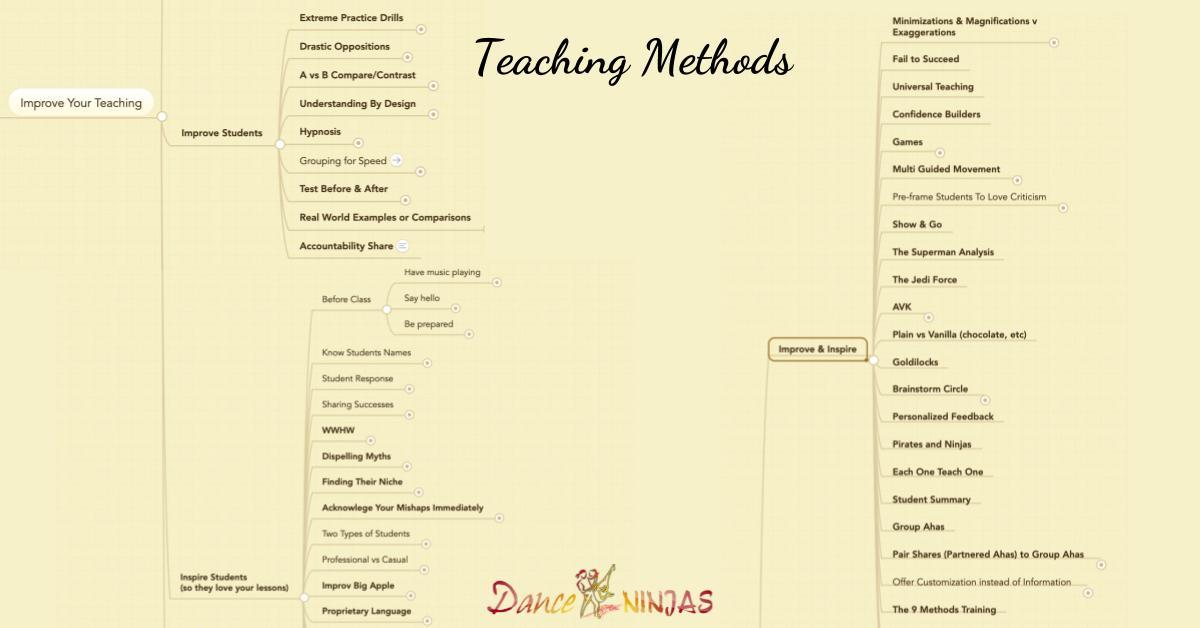Improve Your Teaching: Keep Your Students Coming Back For More
If you want your students to constantly improve, love your lessons, and keep coming back for more, we believe...
...there are 2 key ingredients to make this happen!
- Improve Your Students
- Inspire Your Students
If you improve your students, but you don't inspire them, dancing will probably never be something they fall in love with and they will likely end up losing interest at some point (or continue but only take the occasional lesson and never really be passionate about improving).
If you inspire your students but you don't consistently and clearly improve their dancing, you may keep them around in the short term, but eventually, they will notice they aren't progressing much and will likely start looking for instruction elsewhere.
Improving OR inspiring your students probably isn't enough to keep them in the long run. It's the combination of both that turns students into raving fans and keeps them coming back for years to come (and spreading the word to all their friends).
"Improving OR inspiring your students probably isn't enough to keep them in the long run. It's the combination of both that turns them into raving fans and keeps them coming back for years to come. Prep your lessons to do both!" Andrew Sutton
Now, if you are like the average teacher we have surveyed, you might be thinking "Hmmm, I don't even know what you are talking about."
That is perfectly normal.
But it's time for that to change!
We don't want to help you be a "normal" or "average" teacher.
We want to help you excel and create loads of raving fans that love your lessons and constantly come back for more.
So keep reading and that is exactly what we will do!
Teaching Tip: Holding Back Information Can Hurt You In The Long Run
Some teachers keep their students coming back for more by holding key information back from them for longer than would otherwise be needed. They seem to be afraid that if they give their students everything too soon, the students will have no reason to stick with them.
We believe this will hurt you in the long run and here are several reasons why:
- Most students won't ever learn everything you have to teach them, no matter what pace you go, and the slower pace can frustrate them. So this strategy might create lots more students who stop taking your lessons earlier due to frustration and this probably won't make up for the few students that might stick with you an extra year or two if you slow their progress to try to keep them taking lessons for longer.
- Your reputation for creating kick-ass dancers won't be as awesome, so other potential students will be less likely to take your lessons.
- As long as you keep improving your own dancing, by the time a student does learn everything you currently have to teach them, you will likely have learned a lot more that you can teach them. Speeding up their progress can encourage you to speed up your own progress, whereas slowing it will likely slow you down too.
Note: There is a difference between holding information back to try and keep them coming back for more, compared to not sharing something because it isn't the ideal time in their learning process to learn that information.
Sharing too much all at once can also hold back progress.
A good rule of thumb is to avoid sharing information with your students just because you want them to know it. Share it with them when you have time to let them actually implement it into their dancing (either at that moment or for homework).
At the end of this article, we will share several methods to improve and inspire your students, but first let's discuss how many methods a teacher *needs*, and take an inventory of how many methods you already have.
How Many Methods Does A Teacher *Need*
The good news is...
...you can start your dance career with just one of each (heck, plenty of teachers start with none).
However, as your teaching evolves you want to create more and more, so you can keep things feeling interesting and fresh, all while constantly improving and inspiring your students in each and every single lesson.
The bad news is...
...to keep people around for the long run, you want to have a lot more than one or two methods to improve and inspire your students.
Having lots of different methods allows you to change up your methods and choose the ones that work best for each and every concept, move, technique, etc that you want your students to learn.
Plus, using the exact same methods for everything might eventually feel a bit boring.
There is no exact number of methods that you need, but the more you have, the more you can choose from, and the more likely you will find ones that work really well for you and your students in each situation (not every method works as well for every teacher in every situation).
Now, we know people like to have numbers so we'll share our numbers.
We currently have 58 methods: 9 that improve, 25 that inspire, and 24 that both improve and inspire. The screenshot below shows many of them (maybe you will recognize a few).
Take A Quick Inventory Of Your Methods
More good news...
...you might already use one or two methods that you didn't even realize improve &/or inspire your students.
For example, some teachers "break moves down into smaller chunks" to improve their students and "show a cool move" to inspire them.
While these won't always be the ideal methods to use, they will work great in certain situations.
For example:
- "Breaking things down into smaller chunks" is great for getting them to improve when you know they wouldn't improve as quickly without you breaking it down. That said, this method will slow your students when they don't need the break down.
- "Showing a cool move" is great for inspiring your students when you want to teach them that cool move. That said, this method is probably not ideal when you want them to focus on improving their basics.
Take a few minutes to create your own list of methods you use. Make sure to include when and when not to use them just like we did in the 2 examples above (which we'd recommend you write down on your list as well).
If you don't have many of your own examples yet, don’t worry, we have lots of ways for you to learn more teaching methods.
Learn More Teaching Methods
We have multiple free and paid ways to learn more of our teaching methods.
Let's start with the free stuff!
Free Teaching Methods
To make sure you get all our free content, you can:
Here are some examples of the types of articles we might send you. These articles give you methods that both improve AND inspire your students. Double Whammy!
Again, to make sure you get all our free content:
Paid Teaching Methods
If you want to check out our paid content to improve and inspire your students, you can:
- join our Teacher Training membership site - This is our most affordable and in-depth training. You get 100+ of our best dancing, teaching, and business tips, checklists, and processes.
- join our Dance Instructor Blueprint Masterclass - This is a more advanced group training that we open once every few years. We are working on making it a self-study course that is open year round. If registration isn't currently open, you will be added to our waitlist.
- apply to work with us one-on-one - This gives you the most personalized experience we offer and is the fastest way to progress in your career.
Key Takeaway
To keep your students excited about your lessons (and improving) for many years to come, you want to have lots of methods to inspire them (including methods to get them to want to learn technique, not just moves), and lots of methods to improve them (so you can make drastic improvements in their dancing, not just normal improvements).


